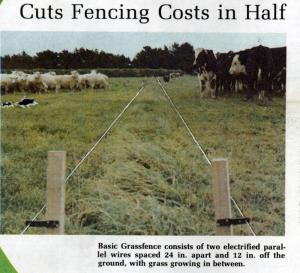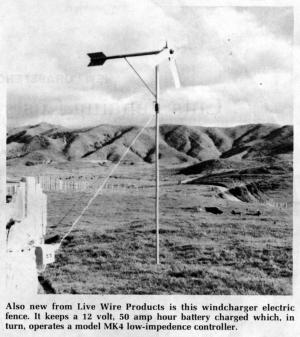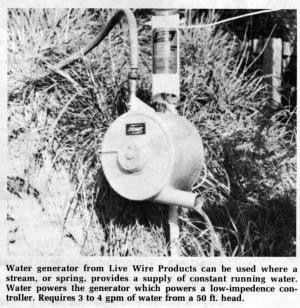1977 - Volume #1, Issue #3, Page #01
[ Sample Stories From This Issue | List of All Stories In This Issue | Print this story
| Read this issue]
New Grassfence Concept Cuts Fencing Costs In Half
 |
 |
 |
The basic Grassfence consists of two parallel electrified wires spaced 24 in. apart and 12 in. off the ground, with grass growing in between.
Grass between the two electrified wires is left to grow into a miniature hedge that never needs mowing or trimming. Cattle and sheep won't graze over the wires, but they will graze inwards under them for about 4 in., explains Jack Henderson, president of Live Wire Products, Grass Valley, Calif., marketer of the newstyle fence which was developed and first introduced three years ago in New Zealand. It's catching on fast on sheep and cattle ranches in that country and now stands ready to show its stuff on U. S. farms and ranches - including yours!
Researchers at the California State University Branch Experiment Station, Chico, Calif., were conducting initial tests with the first U. S.-built Grassfence as this issue of FARM SHOW went to press. Plans had also been finalized by Live Wire Products for making the necessary components for this fencing innovation available to farmers and ranchers who want to be first to test what could prove to be one of the biggest new breakthroughs since single wire electric fence was first introduced.
Key to the success of the new concept is a new, low-impedence controller, designed to maintain constant high power on the fenceline, even under conditions where conventional controllers wouldn't give sufficient shock. "The patented new controller has sufficient power to sear any grass touching the wires, yet is safe to livestock," explains Henderson.
The maximum-power controller (model AK) available from Live Wire Products runs off 110 V. electricity and retails for $159.95. It's powerful enough to handle up to 20 miles of conventional two-wire Grassfence, or up to 40 miles of single wire electric fence. To string 20 miles of Grassfence, your materials cost would be for the controller, 40 miles of 121 ga. smooth galvanized wire, the cost of short wooden posts every 100 ft. or so, depending on the terrain, and insulators for each post.
The new low-impedence controller develops about 5,000 volts, compared to 25,000 to 30,000 volts for conventional weed-chopper type controllers, explains Henderson. "It kills grass without chopping it off, thus reducing the danger of fire. Grassfence requires no earth wires. Metal to metal shorts, one of the most common faults in conventional electric fences, are eliminated."
Here, according to Henderson, are other key features of the new-style electric fence:
• It allows you to rotation graze tame and native pastures, whether 10 or 1,000 acres in size, without having to spend time moving and maintaining the fence - the two big drawbacks with conventional single wire electric fence.
• You can drive over it with your car, truck, tractor or other equipment. Your livestock stay in but you're free to come and go without having to open and close gates.
• Although they're permanent fences and require no mowing or other maintenance, Grassfences can easily be shifted to new locations.
If you're renting or leasing pasture and want to "beef up" a dilapidated fence to make it stock-proof without going to the expense of dismantling or replacing it, simply position Grassfence wires 12 in, on either side and 12 in. above the ground and electrify it with a new low-impedence controller.
Henderson notes that when a Grassfence is first erected, and before grass has had time to grow between the twin wires, animals sometimes do not see them. But, in grazing up to or even initially crossing the Grassfence, they receive a "high energy" shock. After this, they approach the Grassfence wires with caution. They'll eat up to 4 or 5 in. under the wires, but they won't eat over them. Thus, grass in between is left to grow untouched, Henderson explains. Grass in the center continues to grow and eventually reaches a height of approximately 18 in., thus forming a neat and attractive miniature grass hedge.
Excessive pressure from dogs during field trials in New Zealand showed that they can drive animals to cross a Grassfence. But the same field trials also showed that once the pressure is removed, animals do not "remember" that they are capable of crossing a Grassfence. They continue to fear its long grass and to be effectively contained by it, Henderson told FARM SHOW.
For horses, which will jump a conventional two-wire Grassfence, he advises stringing a third wire midway between the two and about 30 to 36 in. off the ground. This third wire can also be used in unusual situations, such as extreme drought stress, where sheep or cattle may begin jumping a two-wire Grassfence. Generally, however, extensive trials in New Zealand have shown that the two-wire configuration is satisfactory for holding cattle and sheep. "We think it will also work for hogs but, at present, we haven't done enough testing with hogs to speak with authority," says Henderson.
How about the effect of a Grassfence on pheasants, grouse or other wildlife? Would the grass strip serve as nesting habitat? Or, would the electrical charge on the low-slung wires tend to scare, injure or possibly even kill pheasants, grouse or other wildlife?
"These are questions yet to be answered," Henderson told FARM SHOW.
For more details on Grassfence, and other fencing innovations shown in the accompanying photos, contact: FARM SHOW Followup, Live Wire Products, Jack Henderson, Pres., Box 150, Grass Valley, Calif. 95945 (ph 916 273-9397).

Click here to download page story appeared in.

Click here to read entire issue
To read the rest of this story, download this issue below or click here to register with your account number.




